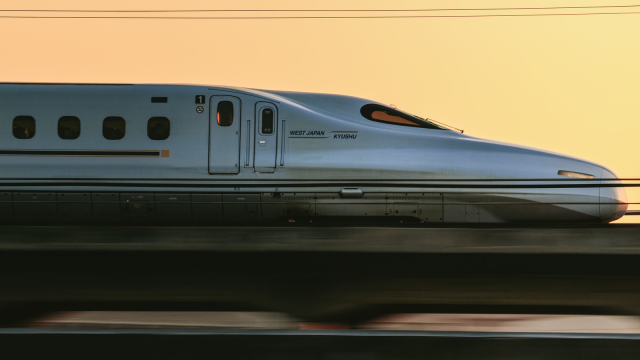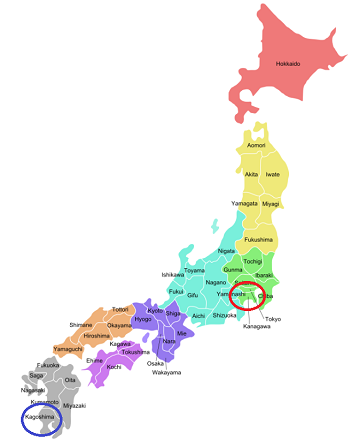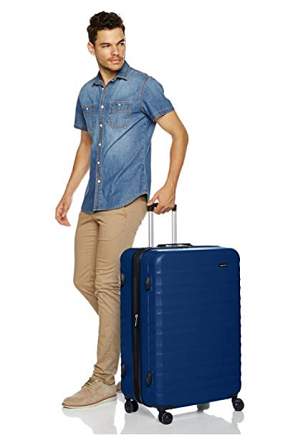
Japan Railway boss says passengers “will be happy” about the new regulations.
The great thing about the Shinkansen, Japan’s bullet train network, isn’t just how fast the trains move, but how convenient they are to use for long-haul travel. If you’re an overseas traveler in Japan, odds are you’re going to have a suitcase or two with you, so it’s especially nice that on the Shinkansen there are no baggage check-in procedures or luggage fees to deal with.
Well, it was especially nice. Unfortunately, the free Shinkansen ride for all luggage is about to become a thing of the past on the most popular Shinkansen lines. Starting in May, passengers planning to take “large suitcases” aboard will have to make reservations for their luggage ahead of time on the Tokkaido Shinkansen, which runs between Tokyo and Shin Osaka, and includes the Shinkansen stop in perennial traveler favorite Kyoto. The restriction will also be introduced on the Sanyo Shinkansen (which runs from Shin Osaka to Hakata, in Fukuoka, and includes Himeji and Hiroshima) and the Kyushu Shinkansen (which runs from Hakata to Kagoshima Chuo).
▼ Tokyo (circled in red) and Kagoshima (blue)
Bringing a large suitcase onto the train won’t automatically incur an extra fee, but it will lock you out of the most affordable seats. That’s because to reserve a spot for a large suitcase, you also have to be travelling by a reserved-seat ticket, which costs a premium over the less expensive non-reserved-seat tickets. Luggage reservations can be made online or at Shinkansen station service counters, but should you fail to make a reservation before getting on the train, you’ll have to pay a 1,000-yen (US$9.25) penalty fee if you want to take your bag with you, as opposed to just leaving it on the platform and tearfully waving goodbye as you zoom off to your next destination.
OK, but what if you show up with a non-reserved-seat ticket and large suitcase? You’ll once again be asked to pay the 1,000-yen penalty, and also to upgrade to a more expensive reserved-seat ticket for an extra 520 yen. Shinkansen operators are currently vague on what will happen if there are no more reserved-seat tickets left, but the assumption is that you’ll be told to wait for the next train, while keeping your fingers crossed that it has available reserved seats.
For purposes of the new regulations, “large suitcases” are described as those with collective length, width, and depth measurements between 160 and 250 centimeters (63 and 98.4 inches). For reference, Japan Airlines’ size limit for carry-on luggage is 55 x 40 x 25 centimeters, total dimensions of 120 centimeters, and the 28-inch suitcase from AmazonBasics pictured below has total dimensions that work out to roughly 159.8 centimeters, depending on how you round.
▼ Shinkansen operators plan to install measuring tables near Shinkansen gates so that you can check whether or not you’ll need to reserve a space for your bag.
JR Tokai (also known as Central Japan Railway Company), JR West, and JR Kyushu, the operators of the Tokkaido, Sanyo, and Kyushu Shinkansen lines, say the change is being implemented as part of increased safety measures for the 2020 Tokyo Olympics and Paralympics, though it’s unclear how the events will constitute a safety issue in Kyushu, on the opposite side of the country from the Games’ Tokyo venues, two months before the opening ceremony takes place.
Aside from the hassles of measuring bags, making reservations, and paying extra fees, the fact that large suitcases will be kept in a locked compartment implies a lengthier boarding/exiting process as staff members verify passengers have made reservations when getting on, and passengers wait for the compartments to be unlocked so they can retrieve their luggage before getting off. Nevertheless, JR Tokai president Shin Kaneko is confident that passengers will not only be accepting of the new system, but actually welcome it. “Under the new system, a need to make reservations for luggage will come about, but the place where the bags are kept is secure, so I think passengers with large suitcases will be happy about it.”
All those who would be happier to not have to deal with all that, though, will also be happy to know that JR East, which operates the Tohoku and Joetsu Shinkansen lines (which run from Tokyo to Shin Aomori and from Omiya to Niigata) has announced no plans to require baggage reservations or fees, nor has the Hokuriku line (Takasaki to Kanazawa).
Sources: NHK News Web via Jin, Travel and Leisure
Top image: Pakutaso
Insert images: Wikipedia/Tokyoship, Amazon
● Want to hear about SoraNews24’s latest articles as soon as they’re published? Follow us on Facebook and Twitter!
You can follow Casey on Twitter regardless of your suitcase size.



 Nozomi Shinkansen bullet train abolishes low-priced unreserved tickets during peak travel seasons
Nozomi Shinkansen bullet train abolishes low-priced unreserved tickets during peak travel seasons Tokaido Shinkansen ending in-train food/drink sales for all non-first-class-passenger cars
Tokaido Shinkansen ending in-train food/drink sales for all non-first-class-passenger cars Free Shinkansen tickets for kids travelling with parents during special JR promotion
Free Shinkansen tickets for kids travelling with parents during special JR promotion Japan is getting a Disney Mickey Mouse Shinkansen bullet train this spring!
Japan is getting a Disney Mickey Mouse Shinkansen bullet train this spring! New Shinkansen bullet train design revealed for Nagasaki extension
New Shinkansen bullet train design revealed for Nagasaki extension Japan’s new difficult-to-drink-from beer glass protects your liver, but it’s a brutal experience
Japan’s new difficult-to-drink-from beer glass protects your liver, but it’s a brutal experience How to order snacks on a Shinkansen bullet train in Japan
How to order snacks on a Shinkansen bullet train in Japan New samurai glasses are Japan’s latest weird must-have souvenir
New samurai glasses are Japan’s latest weird must-have souvenir “Deflowering” services for virgin women are now a thing in Japan, apparently
“Deflowering” services for virgin women are now a thing in Japan, apparently Doraemon found buried at sea as scene from 1993 anime becomes real life【Photos】
Doraemon found buried at sea as scene from 1993 anime becomes real life【Photos】 Burger King Japan suddenly adds Dr. Pepper and Dr. Pepper floats to its menu nationwide
Burger King Japan suddenly adds Dr. Pepper and Dr. Pepper floats to its menu nationwide Hello, cosmetics! Clinique teams up with Hello Kitty this summer for first-time collaboration
Hello, cosmetics! Clinique teams up with Hello Kitty this summer for first-time collaboration Princesses, fruits, and blacksmiths: Study reveals the 30 most unusual family names in Japan
Princesses, fruits, and blacksmiths: Study reveals the 30 most unusual family names in Japan High-fashion Totoro cuddle purse is like an elegant stroll in the forest【Photos】
High-fashion Totoro cuddle purse is like an elegant stroll in the forest【Photos】 Demon Slayer: Kimetsu no Yaiba gets new roller coaster attractions and food at Universal Studios Japan
Demon Slayer: Kimetsu no Yaiba gets new roller coaster attractions and food at Universal Studios Japan Nintendo history you can feel – Super NES, N64, and GameCube controllers become capsule toys
Nintendo history you can feel – Super NES, N64, and GameCube controllers become capsule toys “The most Delicious Cup Noodle in history” – Japan’s French Cup Noodle wins our heart【Taste test】
“The most Delicious Cup Noodle in history” – Japan’s French Cup Noodle wins our heart【Taste test】 Starbucks releases a cute Frappuccino and Unicorn Cake…but not in Japan
Starbucks releases a cute Frappuccino and Unicorn Cake…but not in Japan Kyoto Tower mascot termination reveals dark side behind cute Japanese characters
Kyoto Tower mascot termination reveals dark side behind cute Japanese characters McDonald’s Japan’s Soft Twist Tower: A phantom ice cream only sold at select branches
McDonald’s Japan’s Soft Twist Tower: A phantom ice cream only sold at select branches Yabai Ramen: What makes this Japanese ramen so dangerous?
Yabai Ramen: What makes this Japanese ramen so dangerous? Finally! Nintendo Japan expands Switch 8-bit controller sales to everybody, Online member or not
Finally! Nintendo Japan expands Switch 8-bit controller sales to everybody, Online member or not Japanese government wants to build luxury resorts in all national parks for foreign tourists
Japanese government wants to build luxury resorts in all national parks for foreign tourists To combat declining birth rate, Japan to begin offering “Breeding Visas” to foreigners
To combat declining birth rate, Japan to begin offering “Breeding Visas” to foreigners 10 things you should buy at 7-Eleven in Japan
10 things you should buy at 7-Eleven in Japan Studio Ghibli releases anime heroine cosplay dresses that are super comfy to wear
Studio Ghibli releases anime heroine cosplay dresses that are super comfy to wear Woman charged for driving suitcase without a license in Osaka
Woman charged for driving suitcase without a license in Osaka Studio Ghibli unveils My Neighbour Totoro miniature house model
Studio Ghibli unveils My Neighbour Totoro miniature house model Kyoto experiencing problems with foreign tourists not paying for bus fares, but not on purpose
Kyoto experiencing problems with foreign tourists not paying for bus fares, but not on purpose Fighting mild hunger with a Japanese soda that turns into jelly in the stomach【Taste test】
Fighting mild hunger with a Japanese soda that turns into jelly in the stomach【Taste test】 Studio Ghibli’s Howl’s Moving Castle tapestry unveiled in Japan for first time
Studio Ghibli’s Howl’s Moving Castle tapestry unveiled in Japan for first time McDonald’s new Happy Meals offer up cute and practical Sanrio lifestyle goods
McDonald’s new Happy Meals offer up cute and practical Sanrio lifestyle goods Sales of Japan’s most convenient train ticket/shopping payment cards suspended indefinitely
Sales of Japan’s most convenient train ticket/shopping payment cards suspended indefinitely Sold-out Studio Ghibli desktop humidifiers are back so Totoro can help you through the dry season
Sold-out Studio Ghibli desktop humidifiers are back so Totoro can help you through the dry season Japanese government to make first change to romanization spelling rules since the 1950s
Japanese government to make first change to romanization spelling rules since the 1950s Foreigner’s request for help in Tokyo makes us sad for the state of society
Foreigner’s request for help in Tokyo makes us sad for the state of society Ghibli founders Toshio Suzuki and Hayao Miyazaki contribute to Japanese whisky Totoro label design
Ghibli founders Toshio Suzuki and Hayao Miyazaki contribute to Japanese whisky Totoro label design Tokyo’s most famous Starbucks is closed
Tokyo’s most famous Starbucks is closed The ultimate Shinkansen trip: Riding Japan’s bullet train network from one end to the other
The ultimate Shinkansen trip: Riding Japan’s bullet train network from one end to the other New Japan rail pass gives you a week of free rides in a huge space to chase the cherry blossoms
New Japan rail pass gives you a week of free rides in a huge space to chase the cherry blossoms Shinkansen driver disciplined for taking poop break while train was going 150 kilometers an hour
Shinkansen driver disciplined for taking poop break while train was going 150 kilometers an hour Japan’s Shinkansen bullet trains to remove all onboard payphones
Japan’s Shinkansen bullet trains to remove all onboard payphones Shinkansen travel tip: A clever way to keep your suitcase from rolling around on the bullet train
Shinkansen travel tip: A clever way to keep your suitcase from rolling around on the bullet train Japan’s West Kyushu Shinkansen bullet train service to Nagasaki is set to open this fall
Japan’s West Kyushu Shinkansen bullet train service to Nagasaki is set to open this fall A guide to riding the Shinkansen bullet train with a terrible-twos kid
A guide to riding the Shinkansen bullet train with a terrible-twos kid Disney Shinkansen coming to Japan’s rails, starts service this month
Disney Shinkansen coming to Japan’s rails, starts service this month All Japan Railway Tokyo trains to finally get security cameras starting this summer
All Japan Railway Tokyo trains to finally get security cameras starting this summer Huge price hike for Japan Rail Pass triggers huge drop in foreign travelers who’ll buy it【Survey】
Huge price hike for Japan Rail Pass triggers huge drop in foreign travelers who’ll buy it【Survey】 Potentially dirty and broken used Shinkansen food/beverage carts on sale in Japan for 100,000 yen
Potentially dirty and broken used Shinkansen food/beverage carts on sale in Japan for 100,000 yen New private rooms on Tokaido Shinkansen change the way we travel from Tokyo to Kyoto
New private rooms on Tokaido Shinkansen change the way we travel from Tokyo to Kyoto Human body parts found in crack on bonnet of Shinkansen bullet train
Human body parts found in crack on bonnet of Shinkansen bullet train All-you-can-ride Shinkansen deal coming to Japan for a limited time
All-you-can-ride Shinkansen deal coming to Japan for a limited time Japan’s newest Shinkansen is world’s fastest gallery, packed with contemporary art inside and out
Japan’s newest Shinkansen is world’s fastest gallery, packed with contemporary art inside and out Japan’s Shinkansen bullet train will start offering wider seats, but will charge more for them too
Japan’s Shinkansen bullet train will start offering wider seats, but will charge more for them too Tourists can (finally) make shinkansen reservations from overseas with new app
Tourists can (finally) make shinkansen reservations from overseas with new app
Leave a Reply